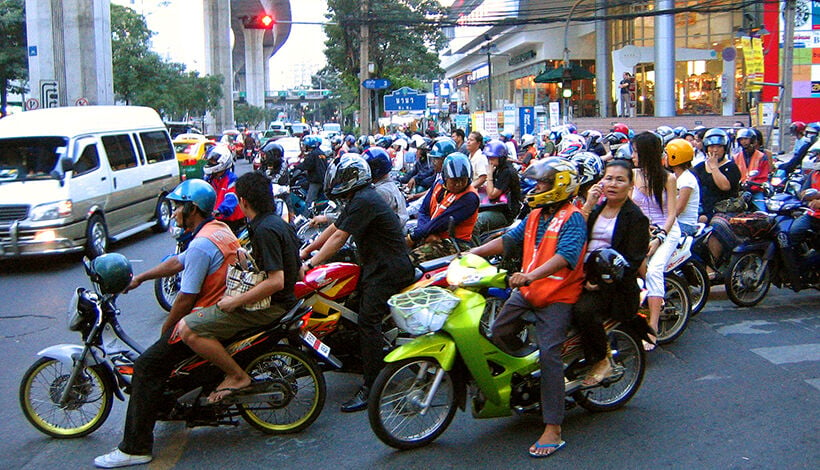Getting a motorcycle taxi in Bangkok, or anywhere in Thailand

We’ll start off by stating that there is nothing quicker and more efficient than getting a motorcycle taxi around Bangkok, compared to just about any other form of transport.
We’ll also admit that there are dangers involved with riding on a motorcycle or motorbike around Thailand, especially if you’re not wearing a helmet (which you can ask the rider for). In practice, the riders always wear a helmet – passengers, rarely.
And we’ll admit that there is a difference between what’s practical, common-practice and ’normal’ regarding getting a motorcycle taxi in Thailand when compared to rules and laws in other countries. For example, you wouldn’t want to have any sort of serious accident on a motorcycle taxi – your insurance is unlikely to cover you in that circumstance.
If you wanted to use the services of a motorcycle taxi, to the letter of the actual laws in Thailand, no one would. But millions do, every day.
Finally, all these tips and tricks are the same for a similar service with Grab or any other ride-hailing app. Except the way your ride is charged, which is an online application that does all that for you, so you know before your rider arrives.
All the pre-amble aside, it remains the easiest way to get point to point for sort distances around the capital. The same applies for anywhere else in Thailand but we predict that 99% of Thailand’s motorcycle taxis are in Bangkok.
Now, in some parts of Thailand, the motorcycle taxi is not as familiar as other parts. In Phuket, for example, the local taxi mafia have limited the use of motorcycle taxis to the extent they’re very difficult to find, except perhaps around Phuket Town.
They’re ubiquitous
You can barely walk 50 – 100 metres without seeing a clump (we’re not sure of the collective noun for motorcycle taxi drivers) of drivers, clad in the orange safety vest, parked by the side of the road, ready to take you wherever you want to go. And, whilst on the road, you’ll see even more of them, in amongst the pink and green-clad delivery service bikes and all the other traffic.
They are, by far, the most popular form of public transport in Thailand.
The drivers are referred to as ‘win’. Or win drivers.
They’re safe, sort of
Considering these (usually) guys do this all day, every day, they’re very skilled at driving a motorbike in and around traffic, with a person, probably heavier than them, perched behind them.
The number of accidents involving motorcycle taxis is very low.
Now, if you suspect your driver isn’t up to the task, or appears drunk or high, just politely decline the ride and keep walking. The next group of drivers isn’t far away. Caveat emptor!
Regarding safety, kudos to Thai ladies who hop on to the back of the seat side-saddle, usually without gripping onto the handle at the back of the seat whilst ordering something from Lazada on their phone or doing their make-up, all in a short skirt and usually with high heels. Skills!
We don’t ever seem to hear about them falling off. How they actually stay on the seat, especially doing a left turn (they always seem to hang their legs to the left) is one of Thailand’s mysterious magic tricks that no westerner will ever, every understand, or master.
Then there are the ‘modern’ Thai women who do it like the guys, with their legs straddled either side of the seat. They either weren’t born with the ‘special’ magic skills or their dress makes that impossible, or unseemly.

They ARE motorcycles, not motorbikes
Locally, they’re called ‘motorcy’ and they are usually smaller Honda or Yamaha motorcycles between 100 and 150 cc. In more than 10 years I have never ridden on anything larger although a few, very few, motorcycle taxi riders do use larger motorbikes. But, 99% of the time you’re going to be perched, gripping the handle on the back of the seat, on a stock, standard factory motorcycle, made in Thailand.
Negotiate your fare before you get on
There are no meters on a motorcycle taxi. The drivers are all part of various gangs around the city and have a “turf” that they dare not stray from. They know the area, within a 2 kilometre radius, intimately – every soi, every building, every bar, every weird pronunciation of all of them.
They also know, with clinical precision, exactly how much it will cost to take you where you want to go. They’ve taken people to your destination hundreds of times (probably). Don’t bother trying to bargain your fare, unless they think you’re a newbie and they quote something outrageous.
Again, after 10 years, I’ve never been cheated, or over-charged, for a motorcycle taxi fare. And that includes hundreds and hundreds of rides.
Typically the fares are around 20 baht for 200 metres – 1 kilometre, then maybe 40 baht for 1 – 2 kilometres. You get the idea… Carry some small change – 10 baht coins, 20, 50 and 100 baht notes with you. Giving them a 1000 baht note for your 20 baht ride is going to become YOUR problem.
English is not their first language
Know where you’re going and have your Google maps open with the destination, or get someone to write the name down for you (in Thai if possible) before you chat to your rider. If you’re barrelling down a road and you think you’re going the wrong way, just gently tap your rider on the shoulder and point towards the kerb. They’ll stop and let you off.
Keeping things simple will make for an easy ride. Complex navigation or bartering for a few baht discount will just confuse and slow down the process. These motorcycle taxi riders make money when they’re taking someone to their destination. They haven’t got the time to faff around with a foreigner who they probably don’t understand.

Be aware of the engineering capabilities of the motorcycle
Motorcycles in Thailand are well capable of carrying two people. I’ve seen up to five. But the law actually restricts riders to just two. Now, just making some gross assumptions here, most adult foreigners are, on average, going to be heavier than the rider at the front. That’s definitely not the safest way to travel with the centre of balance heavily skewed towards the rear of the machine.
So, just use your common sense. If you’re over 100 kilograms, take a normal taxi and just don’t push the engineering limits of the motorbike or the skills of the person steering it.
Equally, if you wobble your weight side to side you’ll make the driver’s job more difficult. And going around corners, just keep behind the driver and don’t try and compensate by leaning in the opposite direction. To put it plainly, just shut up and don’t move around too much.
There will be bumps
You legs will help you grip onto the seat for your side to side movement. But when that motorcycle hits a bump, so will you, propped up there on the rear, directly over the rear wheel. Some of the bikes probably haven’t seen a proper mechanical service for years (although I’ve never experienced a single mechanical or engine failure in a decade), so the shockers on the back may either be a bit worn out, or pushed to the limit with the fat guy on the back.
So expect a few bumps and control your ‘altitude’ with a firm grip on the handle at the rear of the seat. Don’t try to put your hands around the waist of the driver, he’s not going to appreciate it. Or at least take him out on a date first.
Bike helmets are hard
As already mentioned, there probably won’t be a motorbike helmet for the passenger. Thai police completely ignore this when you are on the back of a motorcycle taxi. If you ask for one before you leave the taxi rank (ummm, the side of the road with a grotty old umbrella and a few equally grotty plastic seats) they will usually find one. But, really, it’s just not common practice for the passenger to wear one on a motorcycle taxi, although police will gladly fine two foreigners sharing a motorbike if they don’t both have a bike helmet.
Second note about helmets, they’re hard, of course. But when you’re riding along your face will be directly behind their helmet. In the case of a sudden stop or slow down you may find your face smashing into the rider’s helmet.
Your teeth, whist made from long-wearing calcium and coated in hard enamel, are no match for the hard plastic. Nature didn’t anticipate you’d be riding on the back of a motorcycle taxi in Thailand and your teeth could come off second best if you’re not aware of the possibility of a sudden stop.
This is where another miracle of Thai genetics comes into play where the heads of Thai people appear completely locked from the neck up, and incapable of slamming into the back of the rider’s helmet, whereas foreign necks wobble around like the trinket animal toys sitting on the dashboard of Thai car taxis.
They are quick and efficient
And point to point. If you lined up all the alternatives to getting around just about anywhere in Thailand, the motorcycle taxi will win, every time. When you add the dynamics of traffic in Bangkok, the margin becomes increasingly wider.
The riders will casually make their way through the traffic, fitting through gaps you thought were impossible. Your occasional gasp at their skills in steering between the cars will usually not be appreciated. Just shut up, keep your legs in and marvel at their skill.
Red lights? Well, sometimes you’re just going to have to close your eyes at traffic lights because the full understanding of the purpose of traffic lights may have been lost on some motorcycle taxi riders. Again, your lecture about the way traffic lights work may not be either well understood or appreciated.
Finally
There are inherent dangers of travelling on the back of a motorcycle in Thailand, and The Thaiger doesn’t recommend you do so unless you’ve weighed the risks against the possible advantages.
But the motorcycle taxi is used by hundreds of thousands of passengers every single day, and usually without any misadventure in the vast majority of cases. If you want to experience living in Thailand, as a local, you’re simply going to have to use motorcycle taxis at some time.
Enjoy.

Latest Thailand News
Follow The Thaiger on Google News:



























